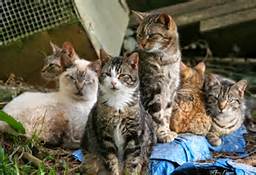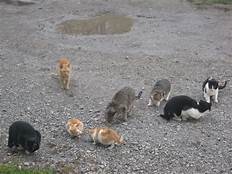Chances are that you will come across stray and feral cats in your lifetime. Whether you spot them in your backyard, around your office park, or while traveling abroad, misconceptions still prevail worldwide about stray and feral cats. Learning the facts can help overturn the myths and stop the overpopulation and mistreatment of homeless cats.
What is a Feral cat?
A feral cat is a cat that lives outdoors and has had little or no human contact. They typically remain hidden from humans and avoid any human contact. Some feral cats become more comfortable with people who regularly feed them. Even with long term attempts at socialization, feral cats usually remain fearful and avoidant of humans. The cats share a common food source and territory. A colony may include not only ferals, but also strays. The more we understand outdoor cats and the complicated issues related to them, the more effectively we can help them, reduce cat overpopulation and protect wildlife.
“Feral” is a behavioral characteristic, not a biological one. While they live outside human homes and exhibit wild behavior, feral cats are not wildlife. In addition, feral is not a black or white quality. Different cats will be feral to different degrees. The vast majority rely on some form of human-based food source for their sustenance. It can be a caretaker who feeds daily, a dumpster behind a supermarket or scraps left on fishing docks. Very few subsist on hunting alone.
What is the difference between a stray and a feral cat?
A lost or abandoned pet is considered a stray cat. It is usually tame enough to be adopted. A feral cat is the offspring of stray or other feral cats surviving outdoors. They are not accustomed to human contact and usually too fearful to be handled or adopted. Feral cats will find it difficult or impossible to adapt to living as pets in close contact with people. But that doesn’t mean there aren’t many things you can do to improve feral cats’ health and quality of life.
Where do community cats live?
Community cats typically live in a colony and consist of related cats. The colony occupies and defends a specific territory where food (a restaurant dumpster or a person who feeds them) and shelter (beneath a porch, in an abandoned building, etc.) are available. Strangers may not realize that feral cats are living nearby. Stray cats tend to be much more visible, may vocalize and approach people in search of food or shelter. Stray cats may join a colony or defend a territory of their own.
Why are outdoor cats a problem?
Nuisance behaviors, such as urinating and defecating in someone’s yard or garden, digging in someone’s yard or garden, jumping on someone’s car and upsetting pets, are the greatest concerns that the general public has about outdoor cats.
Overpopulation is a serious concern as well. Approximately 2 percent of the 30 to 40 million community (feral and stray) cats in the United States have been spayed or neutered. These cats produce around 80 percent of the kittens born in the U.S. each year. Although 85 percent of the estimated 75 to 80 million pet cats in the U.S. are already spayed or neutered, many have kittens before they are spayed or neutered. Those kittens when allowed outdoors, add to the number of outdoor cats and the problems associated with them.
Shelters with a large population of outdoor cats in their communities experience:
- More cats entering shelters as a result of trapping feral adults and kittens young enough to be socialized (tamed).
- Adult feral cats can’t be adopted which causes a rise in euthanasia rates..
- Euthanasia of adoptable cats when cage space runs out.
- Costs associated with trapping and/or caring for and euthanizing feral cats.
In addition, shelters receive many nuisance complaints about outdoor cats, including:
- Frequent, loud noises that are part of the fighting and mating behavior of unneutered/unspayed cats.
- Strong, foul odors left by unneutered male cats spraying urine to mark their territory.
- Flea infestations.
- Visible suffering from injured and dying cats.
- The death of wild animals who are cats’ prey.
What is Trap-Neuter-Return (TNR)?
Spaying or neutering community cats using Trap-Neuter-Return (TNR) will reduce their numbers. Spaying or neutering pet cats before they reproduce will reduce their numbers and help stop pet overpopulation.
TNR is a nonlethal strategy for reducing the number of community cats and improving the quality of life for cats, wildlife and people. At its most basic, TNR involves:
- Humanely trapping community cats
- Spaying or neutering them
- Vaccinating them against rabies
- Returning the cats to their home
How does TNR solve common complaints associated with feral cats?
- When feral cats are trapped, neutered and returned to their territory, they no longer reproduce.
- The cessation of sexual activity eliminates the noise associated with mating behavior and dramatically reduces fighting and the noise it causes.
- Neutered feral cats also roam much less and become less visible and less prone to injury from cars.
- Foul odors are greatly reduced as neutered cats no longer produce testosterone which, when they are unaltered, mixes with their urine and causes the strong, pungent smell of their spraying.
- The population stabilizes and gradually declines over time.
Would it be better if feral cats were euthanized?
Even if the shelter had enough people and money to remove and euthanize the feral cats in a community, other cats would move into the vacated territory to take advantage of the food sources and shelter. The new cats would continue to reproduce and complaint calls would continue. Euthanasia alone won’t rid an area of feral cats, and killing animals to control their numbers is increasingly unpopular with the general public.
The animal welfare community in general is concerned about the health, safety and welfare of the cats in our communities, as well as the public’s health. There is over 20 years of documented proof that traditional ways of dealing with feral cats don’t work. The catch and kill method has not reduced the number of feral cats. While the cat may be gone, there now is room for another cat to move in.
We have all heard the saying, “Nature abhors a vacuum.” By creating that hole in a neighborhood feral cat colony, we encourage fighting, spraying of territory and breeding. In addition, female cats in distressed colonies tend to produce more offspring than those in stable colonies. So, catch and kill actually makes the problem worse.
The Trap, Neuter and Return (TNR) of feral cats is a proven, humane method of feral cat population control. TNR humanely trap, sterilize and release the cats back into the environment in which they were living.
Won’t removing community cats from an area eliminate the problem?
Trapping and removing a colony rarely solves cat problems. Community cats live at a certain location because it offers food and shelter. By removing a colony, cats from surrounding colonies move in to take advantage of the newly available resources. The cycle of reproduction and nuisance behavior begins all over again.
Here are some of the other factors that usually make trap and removal ineffective:
- No input from the cats’ caretakers, who are the only people who really know the cats’ numbers and patterns and can control whether or not the cats are hungry enough to enter a baited trap
- No volunteers to trap cats, who face an uncertain fate or death upon capture
- Little to no animal control staff and money available to accomplish the task
- No strategy for the difficult task of catching all the cats in a colony
- A vacated territory quickly repopulates
 Why don’t feeding bans eliminate community cats?
Why don’t feeding bans eliminate community cats?
The logic behind bans on feeding feral cats is that if there is no food available, the cats will go away. This rarely happens. First, cats are territorial animals who can survive for weeks without food and will not easily or quickly abandon their territory. As they grow hungrier and more desperate, they tend to venture closer to homes and businesses in search of food. Despite the effort to starve them out, the cats will also continue to reproduce, resulting in the deaths of many kittens.
Second, feeding bans are nearly impossible to enforce. Repeated experience has shown that people who care about the cats will go to great lengths to care for them. They might risk their homes, jobs and even their liberty to feed starving animals. In addition, there may be more than one feeder and other sources of food, including dumpsters, garbage cans and other animals.
Anyone Can Become a Caretaker
Feral cats have a rough life and live, on average, two years on their own. With regular care, which includes reliable shelter and daily feedings similar to the care of barnyard cats, they can live as long as ten years. If you decide to become a caretaker, an important lesson is to never forcefully grab an outdoor cat or make a sudden movement towards it. These cats are fearful of people and tend to run away as strangers approach them. Let the feral or stray cat come closer to you on his/her terms.
Through daily feedings, in time they will let you know if it’s acceptable to touch them. If you do decide to become a caretaker, squat or sit on the ground so you’re at their level when you regularly feed them. This approach indicates to the feral or stray cat that you are not threatening.
In conclusion, I hope this helps you to understand feral cats and their colonies. Work with your local animal shelters and use community resources to help stabilize the feral cat colonies in your community.




